System Analysis and Design for Wide World Tour Management System
VerifiedAdded on 2022/08/26
|9
|1748
|22
AI Summary
Contribute Materials
Your contribution can guide someone’s learning journey. Share your
documents today.
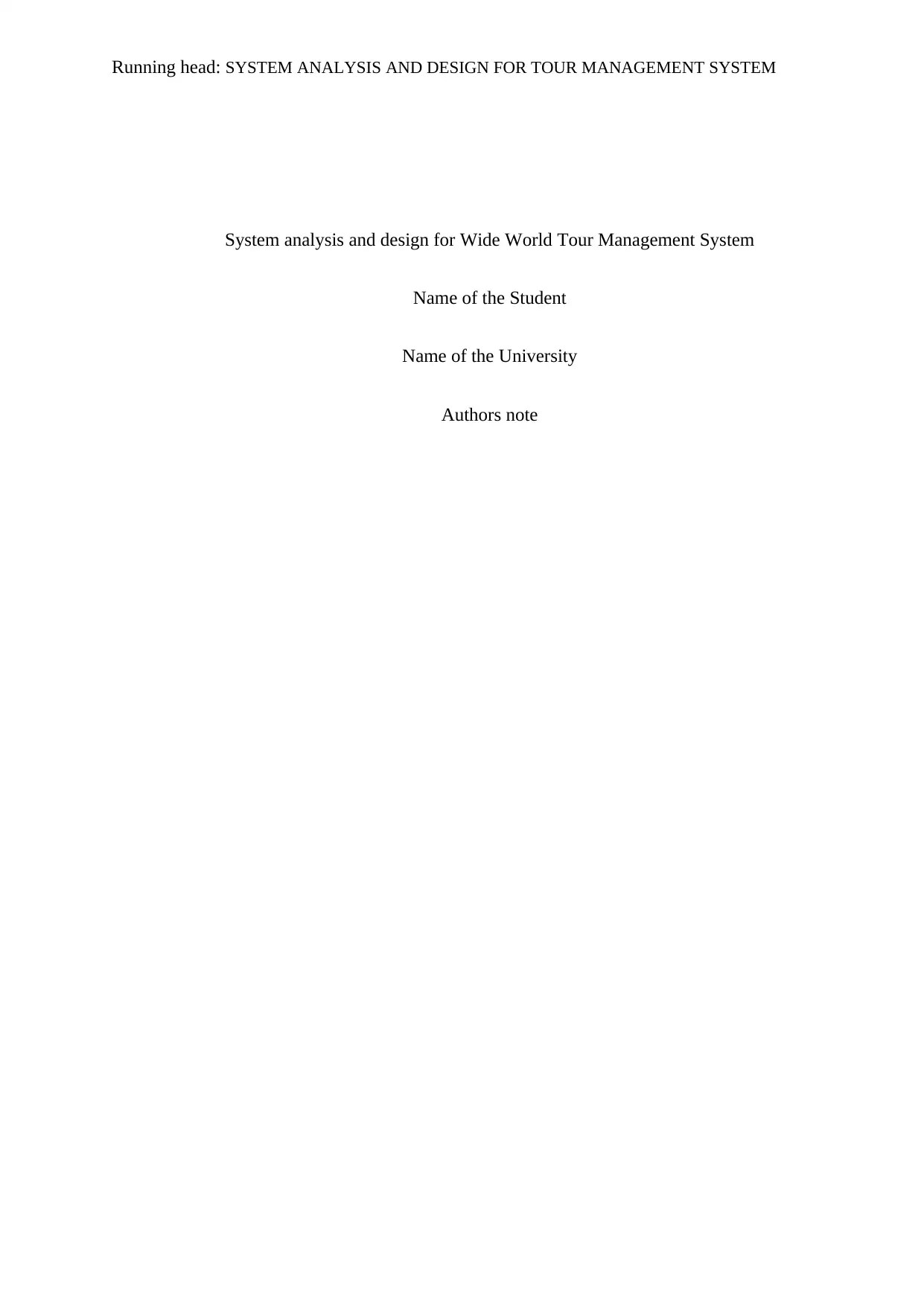
Running head: SYSTEM ANALYSIS AND DESIGN FOR TOUR MANAGEMENT SYSTEM
System analysis and design for Wide World Tour Management System
Name of the Student
Name of the University
Authors note
System analysis and design for Wide World Tour Management System
Name of the Student
Name of the University
Authors note
Secure Best Marks with AI Grader
Need help grading? Try our AI Grader for instant feedback on your assignments.
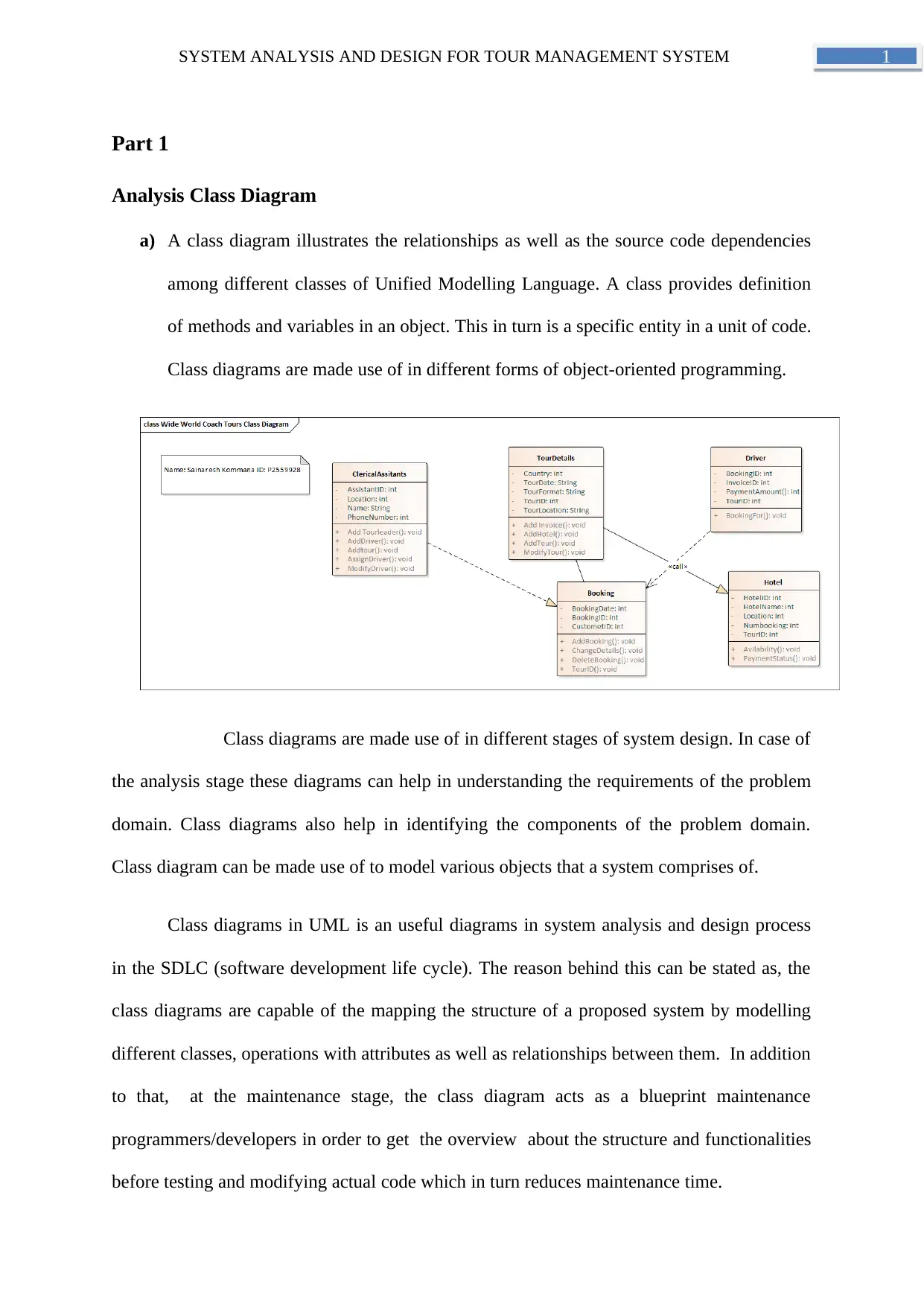
1SYSTEM ANALYSIS AND DESIGN FOR TOUR MANAGEMENT SYSTEM
Part 1
Analysis Class Diagram
a) A class diagram illustrates the relationships as well as the source code dependencies
among different classes of Unified Modelling Language. A class provides definition
of methods and variables in an object. This in turn is a specific entity in a unit of code.
Class diagrams are made use of in different forms of object-oriented programming.
Class diagrams are made use of in different stages of system design. In case of
the analysis stage these diagrams can help in understanding the requirements of the problem
domain. Class diagrams also help in identifying the components of the problem domain.
Class diagram can be made use of to model various objects that a system comprises of.
Class diagrams in UML is an useful diagrams in system analysis and design process
in the SDLC (software development life cycle). The reason behind this can be stated as, the
class diagrams are capable of the mapping the structure of a proposed system by modelling
different classes, operations with attributes as well as relationships between them. In addition
to that, at the maintenance stage, the class diagram acts as a blueprint maintenance
programmers/developers in order to get the overview about the structure and functionalities
before testing and modifying actual code which in turn reduces maintenance time.
Part 1
Analysis Class Diagram
a) A class diagram illustrates the relationships as well as the source code dependencies
among different classes of Unified Modelling Language. A class provides definition
of methods and variables in an object. This in turn is a specific entity in a unit of code.
Class diagrams are made use of in different forms of object-oriented programming.
Class diagrams are made use of in different stages of system design. In case of
the analysis stage these diagrams can help in understanding the requirements of the problem
domain. Class diagrams also help in identifying the components of the problem domain.
Class diagram can be made use of to model various objects that a system comprises of.
Class diagrams in UML is an useful diagrams in system analysis and design process
in the SDLC (software development life cycle). The reason behind this can be stated as, the
class diagrams are capable of the mapping the structure of a proposed system by modelling
different classes, operations with attributes as well as relationships between them. In addition
to that, at the maintenance stage, the class diagram acts as a blueprint maintenance
programmers/developers in order to get the overview about the structure and functionalities
before testing and modifying actual code which in turn reduces maintenance time.
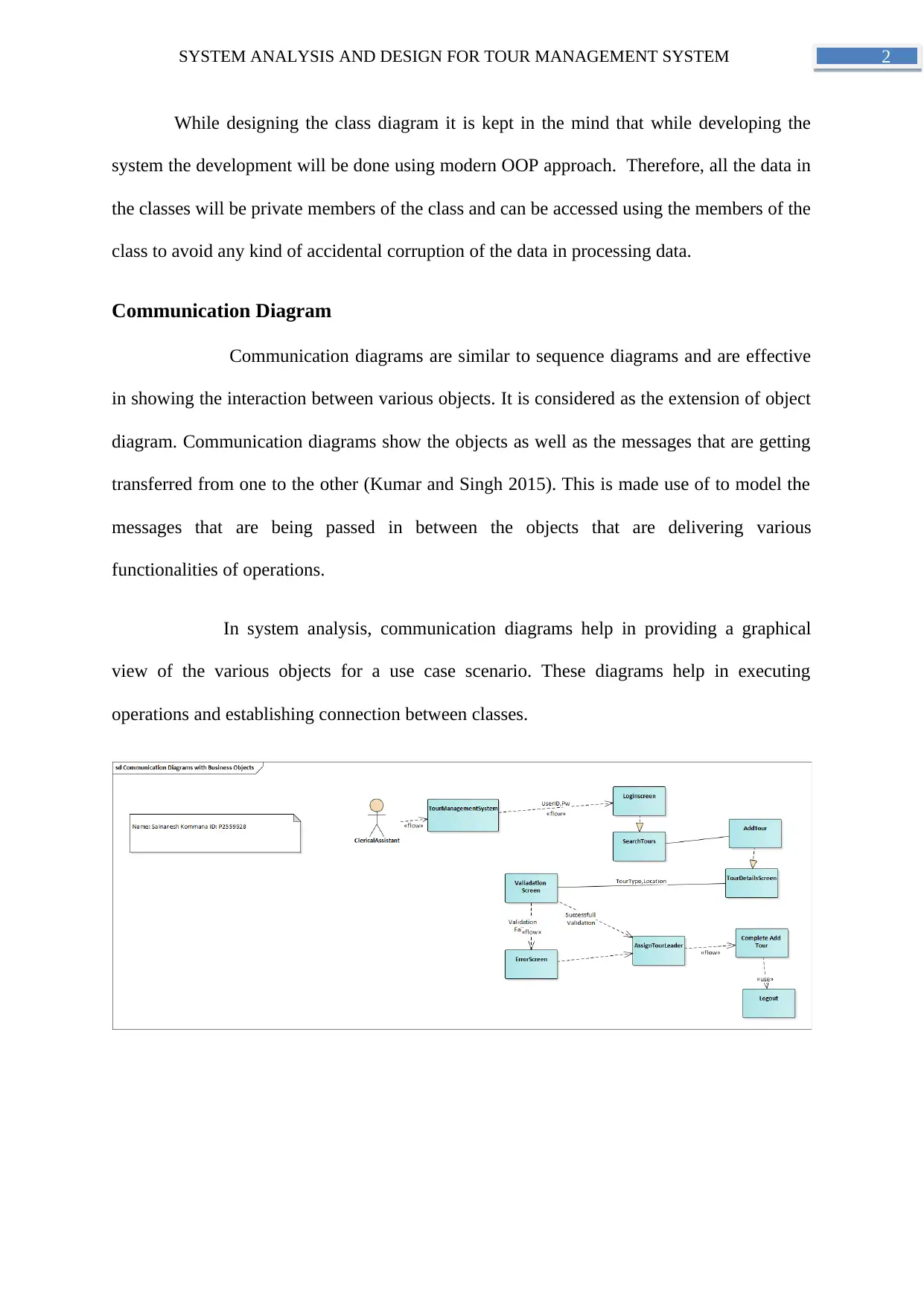
2SYSTEM ANALYSIS AND DESIGN FOR TOUR MANAGEMENT SYSTEM
While designing the class diagram it is kept in the mind that while developing the
system the development will be done using modern OOP approach. Therefore, all the data in
the classes will be private members of the class and can be accessed using the members of the
class to avoid any kind of accidental corruption of the data in processing data.
Communication Diagram
Communication diagrams are similar to sequence diagrams and are effective
in showing the interaction between various objects. It is considered as the extension of object
diagram. Communication diagrams show the objects as well as the messages that are getting
transferred from one to the other (Kumar and Singh 2015). This is made use of to model the
messages that are being passed in between the objects that are delivering various
functionalities of operations.
In system analysis, communication diagrams help in providing a graphical
view of the various objects for a use case scenario. These diagrams help in executing
operations and establishing connection between classes.
While designing the class diagram it is kept in the mind that while developing the
system the development will be done using modern OOP approach. Therefore, all the data in
the classes will be private members of the class and can be accessed using the members of the
class to avoid any kind of accidental corruption of the data in processing data.
Communication Diagram
Communication diagrams are similar to sequence diagrams and are effective
in showing the interaction between various objects. It is considered as the extension of object
diagram. Communication diagrams show the objects as well as the messages that are getting
transferred from one to the other (Kumar and Singh 2015). This is made use of to model the
messages that are being passed in between the objects that are delivering various
functionalities of operations.
In system analysis, communication diagrams help in providing a graphical
view of the various objects for a use case scenario. These diagrams help in executing
operations and establishing connection between classes.
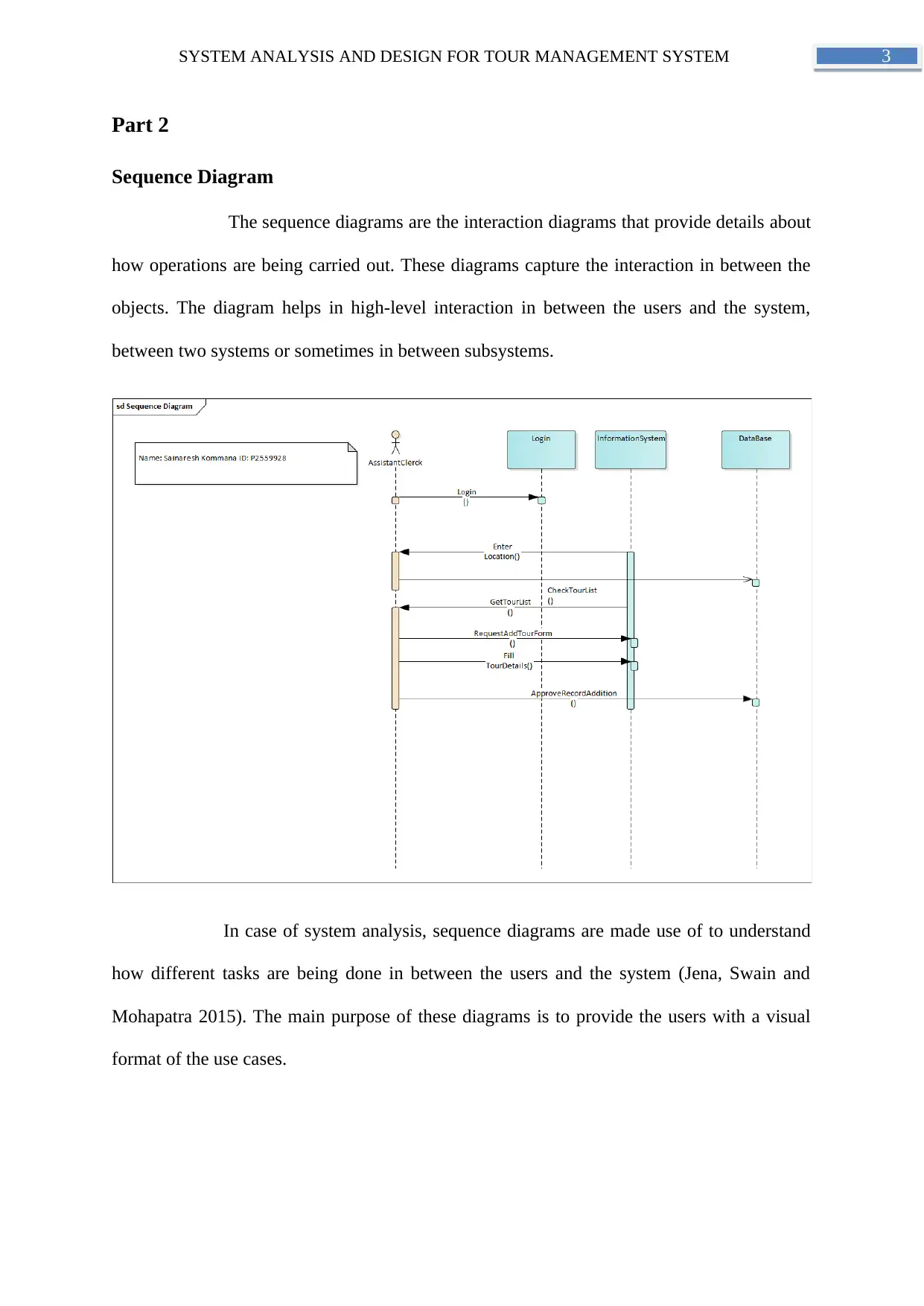
3SYSTEM ANALYSIS AND DESIGN FOR TOUR MANAGEMENT SYSTEM
Part 2
Sequence Diagram
The sequence diagrams are the interaction diagrams that provide details about
how operations are being carried out. These diagrams capture the interaction in between the
objects. The diagram helps in high-level interaction in between the users and the system,
between two systems or sometimes in between subsystems.
In case of system analysis, sequence diagrams are made use of to understand
how different tasks are being done in between the users and the system (Jena, Swain and
Mohapatra 2015). The main purpose of these diagrams is to provide the users with a visual
format of the use cases.
Part 2
Sequence Diagram
The sequence diagrams are the interaction diagrams that provide details about
how operations are being carried out. These diagrams capture the interaction in between the
objects. The diagram helps in high-level interaction in between the users and the system,
between two systems or sometimes in between subsystems.
In case of system analysis, sequence diagrams are made use of to understand
how different tasks are being done in between the users and the system (Jena, Swain and
Mohapatra 2015). The main purpose of these diagrams is to provide the users with a visual
format of the use cases.
Secure Best Marks with AI Grader
Need help grading? Try our AI Grader for instant feedback on your assignments.
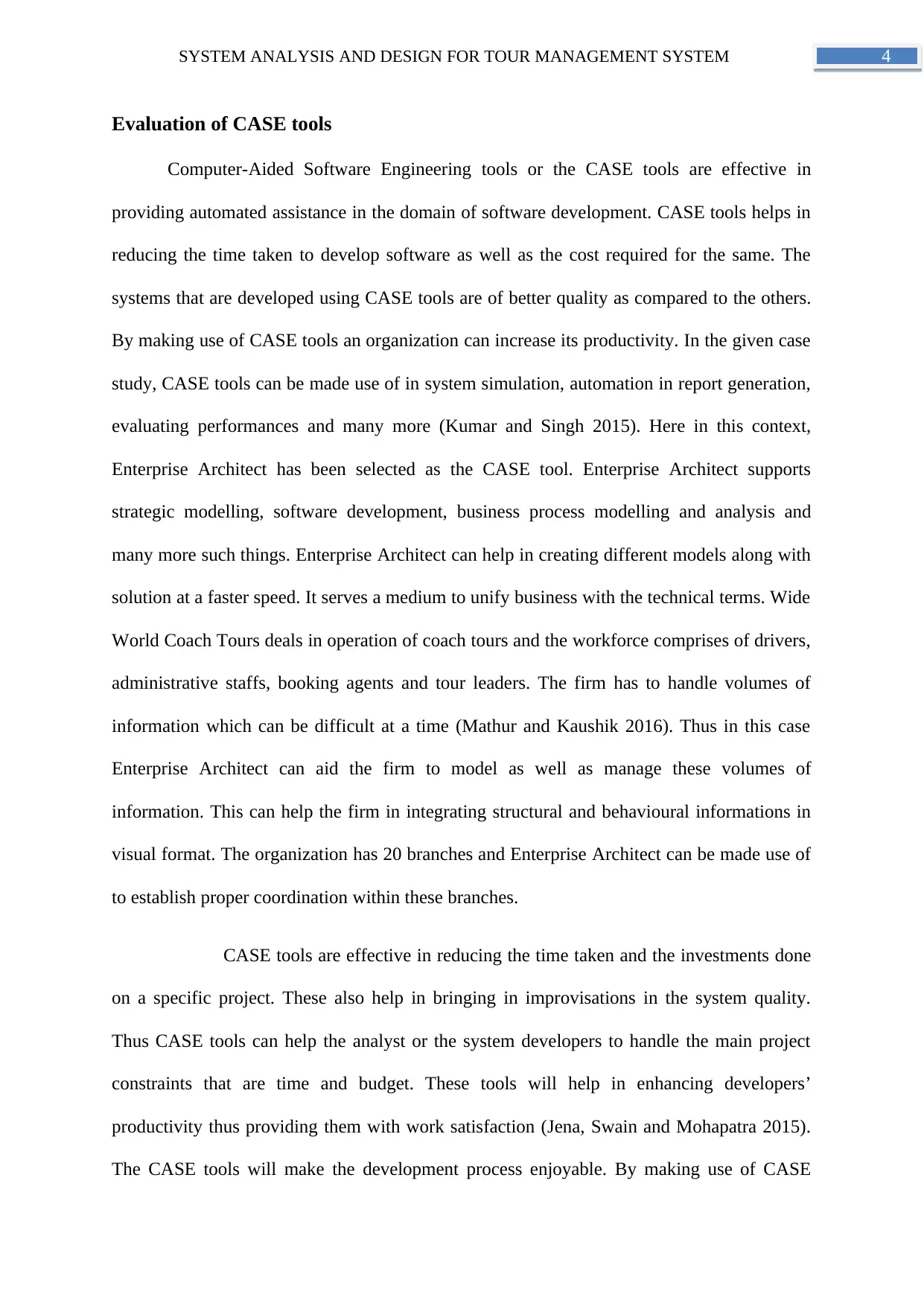
4SYSTEM ANALYSIS AND DESIGN FOR TOUR MANAGEMENT SYSTEM
Evaluation of CASE tools
Computer-Aided Software Engineering tools or the CASE tools are effective in
providing automated assistance in the domain of software development. CASE tools helps in
reducing the time taken to develop software as well as the cost required for the same. The
systems that are developed using CASE tools are of better quality as compared to the others.
By making use of CASE tools an organization can increase its productivity. In the given case
study, CASE tools can be made use of in system simulation, automation in report generation,
evaluating performances and many more (Kumar and Singh 2015). Here in this context,
Enterprise Architect has been selected as the CASE tool. Enterprise Architect supports
strategic modelling, software development, business process modelling and analysis and
many more such things. Enterprise Architect can help in creating different models along with
solution at a faster speed. It serves a medium to unify business with the technical terms. Wide
World Coach Tours deals in operation of coach tours and the workforce comprises of drivers,
administrative staffs, booking agents and tour leaders. The firm has to handle volumes of
information which can be difficult at a time (Mathur and Kaushik 2016). Thus in this case
Enterprise Architect can aid the firm to model as well as manage these volumes of
information. This can help the firm in integrating structural and behavioural informations in
visual format. The organization has 20 branches and Enterprise Architect can be made use of
to establish proper coordination within these branches.
CASE tools are effective in reducing the time taken and the investments done
on a specific project. These also help in bringing in improvisations in the system quality.
Thus CASE tools can help the analyst or the system developers to handle the main project
constraints that are time and budget. These tools will help in enhancing developers’
productivity thus providing them with work satisfaction (Jena, Swain and Mohapatra 2015).
The CASE tools will make the development process enjoyable. By making use of CASE
Evaluation of CASE tools
Computer-Aided Software Engineering tools or the CASE tools are effective in
providing automated assistance in the domain of software development. CASE tools helps in
reducing the time taken to develop software as well as the cost required for the same. The
systems that are developed using CASE tools are of better quality as compared to the others.
By making use of CASE tools an organization can increase its productivity. In the given case
study, CASE tools can be made use of in system simulation, automation in report generation,
evaluating performances and many more (Kumar and Singh 2015). Here in this context,
Enterprise Architect has been selected as the CASE tool. Enterprise Architect supports
strategic modelling, software development, business process modelling and analysis and
many more such things. Enterprise Architect can help in creating different models along with
solution at a faster speed. It serves a medium to unify business with the technical terms. Wide
World Coach Tours deals in operation of coach tours and the workforce comprises of drivers,
administrative staffs, booking agents and tour leaders. The firm has to handle volumes of
information which can be difficult at a time (Mathur and Kaushik 2016). Thus in this case
Enterprise Architect can aid the firm to model as well as manage these volumes of
information. This can help the firm in integrating structural and behavioural informations in
visual format. The organization has 20 branches and Enterprise Architect can be made use of
to establish proper coordination within these branches.
CASE tools are effective in reducing the time taken and the investments done
on a specific project. These also help in bringing in improvisations in the system quality.
Thus CASE tools can help the analyst or the system developers to handle the main project
constraints that are time and budget. These tools will help in enhancing developers’
productivity thus providing them with work satisfaction (Jena, Swain and Mohapatra 2015).
The CASE tools will make the development process enjoyable. By making use of CASE
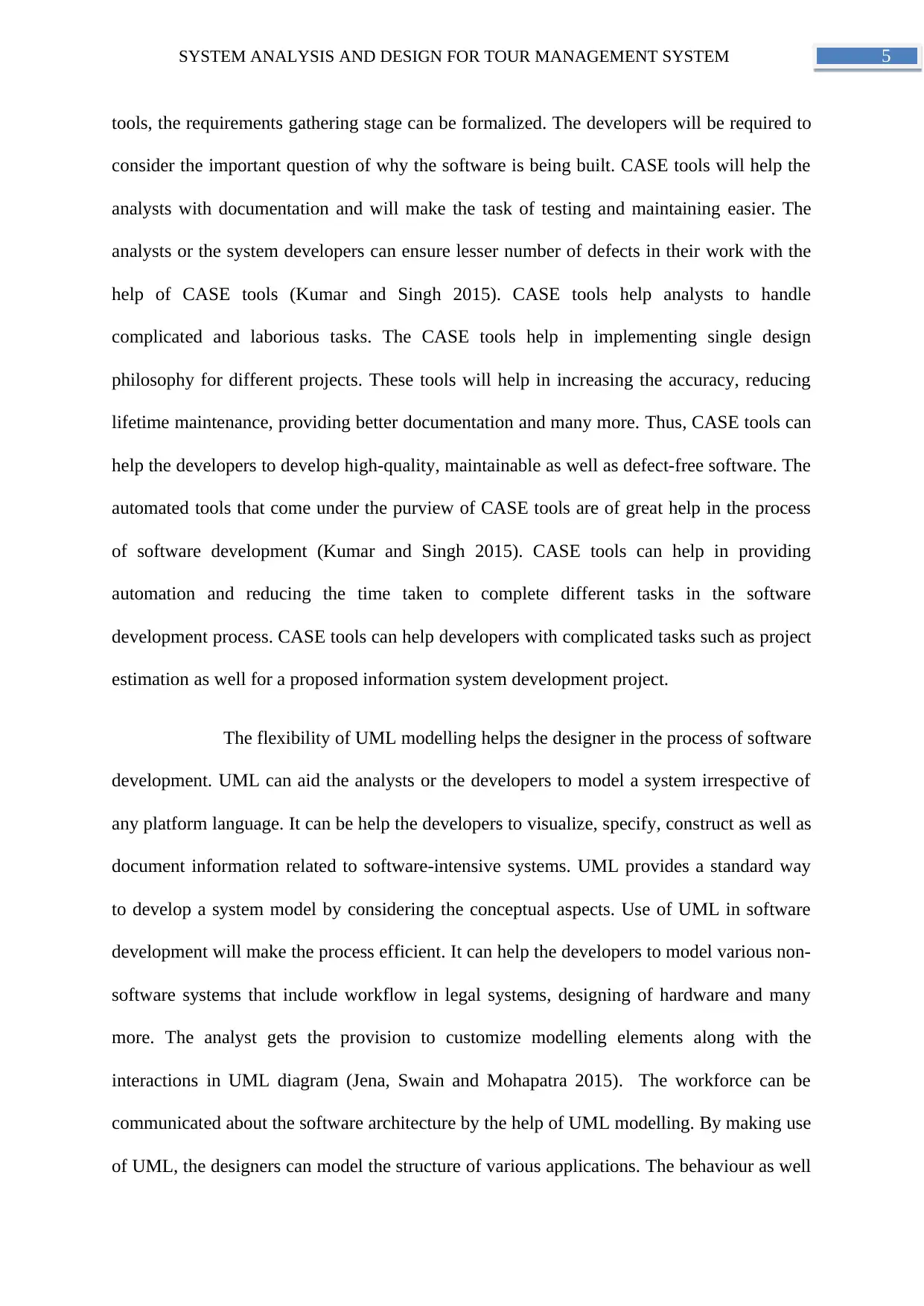
5SYSTEM ANALYSIS AND DESIGN FOR TOUR MANAGEMENT SYSTEM
tools, the requirements gathering stage can be formalized. The developers will be required to
consider the important question of why the software is being built. CASE tools will help the
analysts with documentation and will make the task of testing and maintaining easier. The
analysts or the system developers can ensure lesser number of defects in their work with the
help of CASE tools (Kumar and Singh 2015). CASE tools help analysts to handle
complicated and laborious tasks. The CASE tools help in implementing single design
philosophy for different projects. These tools will help in increasing the accuracy, reducing
lifetime maintenance, providing better documentation and many more. Thus, CASE tools can
help the developers to develop high-quality, maintainable as well as defect-free software. The
automated tools that come under the purview of CASE tools are of great help in the process
of software development (Kumar and Singh 2015). CASE tools can help in providing
automation and reducing the time taken to complete different tasks in the software
development process. CASE tools can help developers with complicated tasks such as project
estimation as well for a proposed information system development project.
The flexibility of UML modelling helps the designer in the process of software
development. UML can aid the analysts or the developers to model a system irrespective of
any platform language. It can be help the developers to visualize, specify, construct as well as
document information related to software-intensive systems. UML provides a standard way
to develop a system model by considering the conceptual aspects. Use of UML in software
development will make the process efficient. It can help the developers to model various non-
software systems that include workflow in legal systems, designing of hardware and many
more. The analyst gets the provision to customize modelling elements along with the
interactions in UML diagram (Jena, Swain and Mohapatra 2015). The workforce can be
communicated about the software architecture by the help of UML modelling. By making use
of UML, the designers can model the structure of various applications. The behaviour as well
tools, the requirements gathering stage can be formalized. The developers will be required to
consider the important question of why the software is being built. CASE tools will help the
analysts with documentation and will make the task of testing and maintaining easier. The
analysts or the system developers can ensure lesser number of defects in their work with the
help of CASE tools (Kumar and Singh 2015). CASE tools help analysts to handle
complicated and laborious tasks. The CASE tools help in implementing single design
philosophy for different projects. These tools will help in increasing the accuracy, reducing
lifetime maintenance, providing better documentation and many more. Thus, CASE tools can
help the developers to develop high-quality, maintainable as well as defect-free software. The
automated tools that come under the purview of CASE tools are of great help in the process
of software development (Kumar and Singh 2015). CASE tools can help in providing
automation and reducing the time taken to complete different tasks in the software
development process. CASE tools can help developers with complicated tasks such as project
estimation as well for a proposed information system development project.
The flexibility of UML modelling helps the designer in the process of software
development. UML can aid the analysts or the developers to model a system irrespective of
any platform language. It can be help the developers to visualize, specify, construct as well as
document information related to software-intensive systems. UML provides a standard way
to develop a system model by considering the conceptual aspects. Use of UML in software
development will make the process efficient. It can help the developers to model various non-
software systems that include workflow in legal systems, designing of hardware and many
more. The analyst gets the provision to customize modelling elements along with the
interactions in UML diagram (Jena, Swain and Mohapatra 2015). The workforce can be
communicated about the software architecture by the help of UML modelling. By making use
of UML, the designers can model the structure of various applications. The behaviour as well
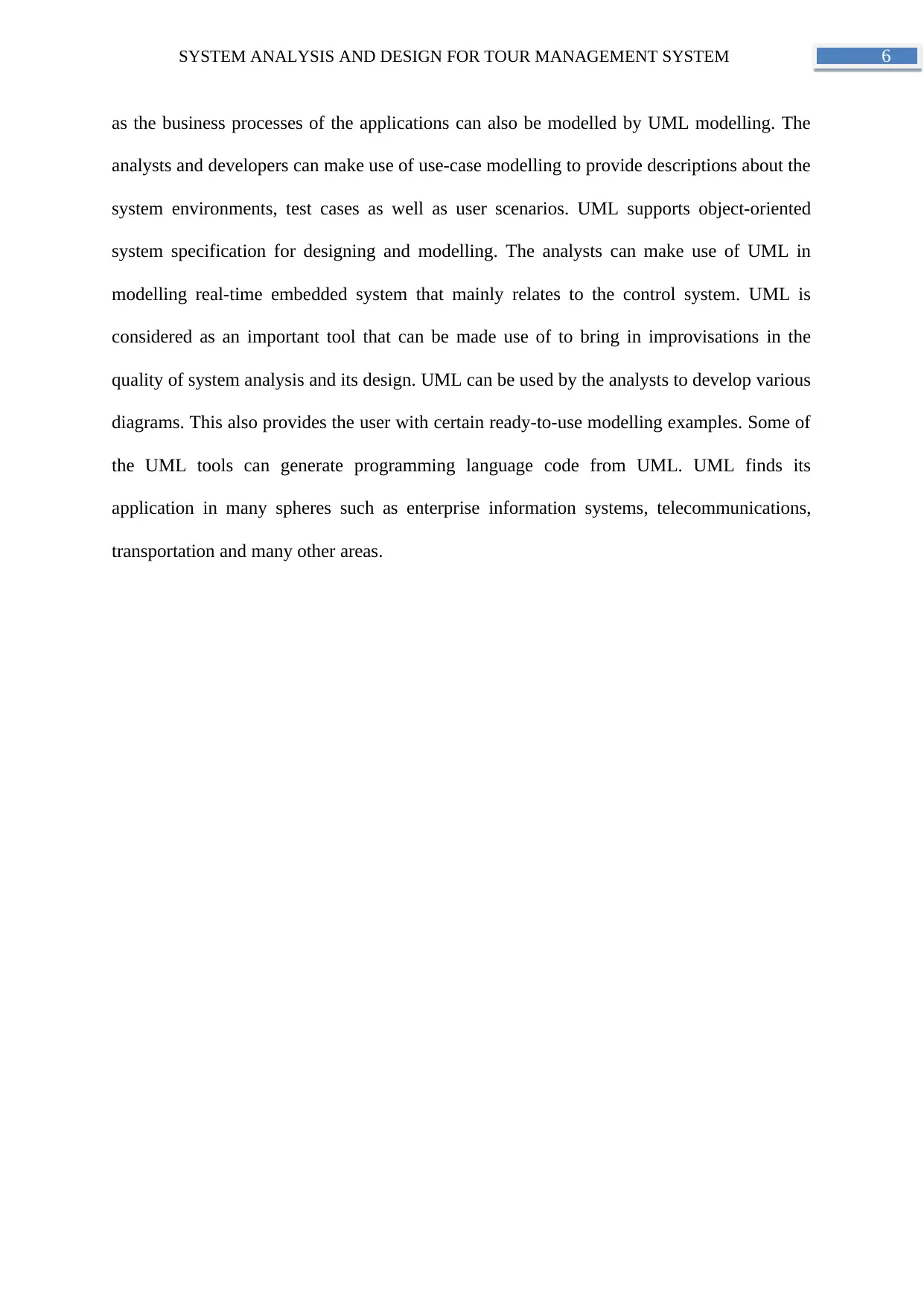
6SYSTEM ANALYSIS AND DESIGN FOR TOUR MANAGEMENT SYSTEM
as the business processes of the applications can also be modelled by UML modelling. The
analysts and developers can make use of use-case modelling to provide descriptions about the
system environments, test cases as well as user scenarios. UML supports object-oriented
system specification for designing and modelling. The analysts can make use of UML in
modelling real-time embedded system that mainly relates to the control system. UML is
considered as an important tool that can be made use of to bring in improvisations in the
quality of system analysis and its design. UML can be used by the analysts to develop various
diagrams. This also provides the user with certain ready-to-use modelling examples. Some of
the UML tools can generate programming language code from UML. UML finds its
application in many spheres such as enterprise information systems, telecommunications,
transportation and many other areas.
as the business processes of the applications can also be modelled by UML modelling. The
analysts and developers can make use of use-case modelling to provide descriptions about the
system environments, test cases as well as user scenarios. UML supports object-oriented
system specification for designing and modelling. The analysts can make use of UML in
modelling real-time embedded system that mainly relates to the control system. UML is
considered as an important tool that can be made use of to bring in improvisations in the
quality of system analysis and its design. UML can be used by the analysts to develop various
diagrams. This also provides the user with certain ready-to-use modelling examples. Some of
the UML tools can generate programming language code from UML. UML finds its
application in many spheres such as enterprise information systems, telecommunications,
transportation and many other areas.
Paraphrase This Document
Need a fresh take? Get an instant paraphrase of this document with our AI Paraphraser
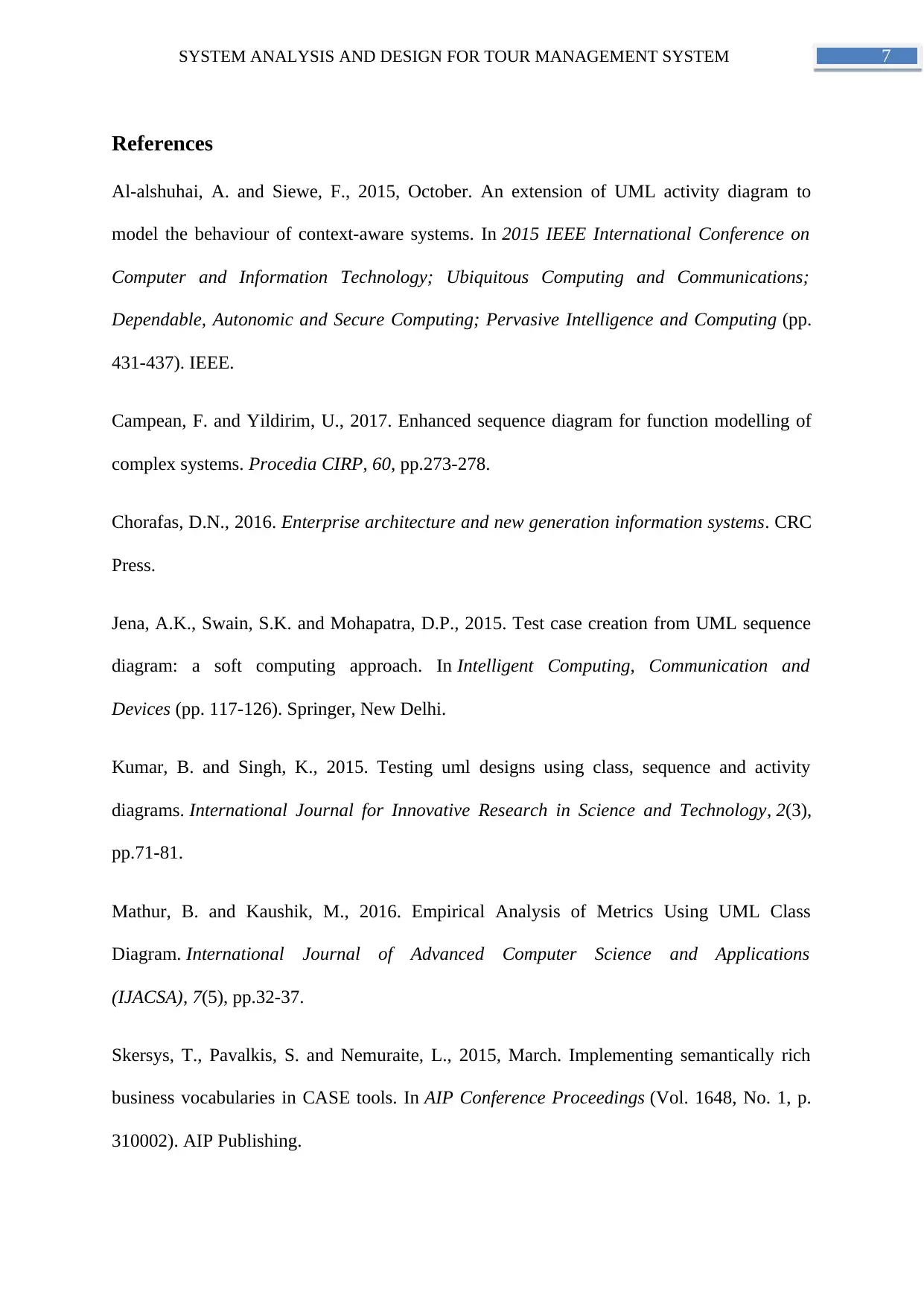
7SYSTEM ANALYSIS AND DESIGN FOR TOUR MANAGEMENT SYSTEM
References
Al-alshuhai, A. and Siewe, F., 2015, October. An extension of UML activity diagram to
model the behaviour of context-aware systems. In 2015 IEEE International Conference on
Computer and Information Technology; Ubiquitous Computing and Communications;
Dependable, Autonomic and Secure Computing; Pervasive Intelligence and Computing (pp.
431-437). IEEE.
Campean, F. and Yildirim, U., 2017. Enhanced sequence diagram for function modelling of
complex systems. Procedia CIRP, 60, pp.273-278.
Chorafas, D.N., 2016. Enterprise architecture and new generation information systems. CRC
Press.
Jena, A.K., Swain, S.K. and Mohapatra, D.P., 2015. Test case creation from UML sequence
diagram: a soft computing approach. In Intelligent Computing, Communication and
Devices (pp. 117-126). Springer, New Delhi.
Kumar, B. and Singh, K., 2015. Testing uml designs using class, sequence and activity
diagrams. International Journal for Innovative Research in Science and Technology, 2(3),
pp.71-81.
Mathur, B. and Kaushik, M., 2016. Empirical Analysis of Metrics Using UML Class
Diagram. International Journal of Advanced Computer Science and Applications
(IJACSA), 7(5), pp.32-37.
Skersys, T., Pavalkis, S. and Nemuraite, L., 2015, March. Implementing semantically rich
business vocabularies in CASE tools. In AIP Conference Proceedings (Vol. 1648, No. 1, p.
310002). AIP Publishing.
References
Al-alshuhai, A. and Siewe, F., 2015, October. An extension of UML activity diagram to
model the behaviour of context-aware systems. In 2015 IEEE International Conference on
Computer and Information Technology; Ubiquitous Computing and Communications;
Dependable, Autonomic and Secure Computing; Pervasive Intelligence and Computing (pp.
431-437). IEEE.
Campean, F. and Yildirim, U., 2017. Enhanced sequence diagram for function modelling of
complex systems. Procedia CIRP, 60, pp.273-278.
Chorafas, D.N., 2016. Enterprise architecture and new generation information systems. CRC
Press.
Jena, A.K., Swain, S.K. and Mohapatra, D.P., 2015. Test case creation from UML sequence
diagram: a soft computing approach. In Intelligent Computing, Communication and
Devices (pp. 117-126). Springer, New Delhi.
Kumar, B. and Singh, K., 2015. Testing uml designs using class, sequence and activity
diagrams. International Journal for Innovative Research in Science and Technology, 2(3),
pp.71-81.
Mathur, B. and Kaushik, M., 2016. Empirical Analysis of Metrics Using UML Class
Diagram. International Journal of Advanced Computer Science and Applications
(IJACSA), 7(5), pp.32-37.
Skersys, T., Pavalkis, S. and Nemuraite, L., 2015, March. Implementing semantically rich
business vocabularies in CASE tools. In AIP Conference Proceedings (Vol. 1648, No. 1, p.
310002). AIP Publishing.

8SYSTEM ANALYSIS AND DESIGN FOR TOUR MANAGEMENT SYSTEM
1 out of 9
Related Documents
Your All-in-One AI-Powered Toolkit for Academic Success.
+13062052269
info@desklib.com
Available 24*7 on WhatsApp / Email
![[object Object]](/_next/static/media/star-bottom.7253800d.svg)
Unlock your academic potential
© 2024 | Zucol Services PVT LTD | All rights reserved.





